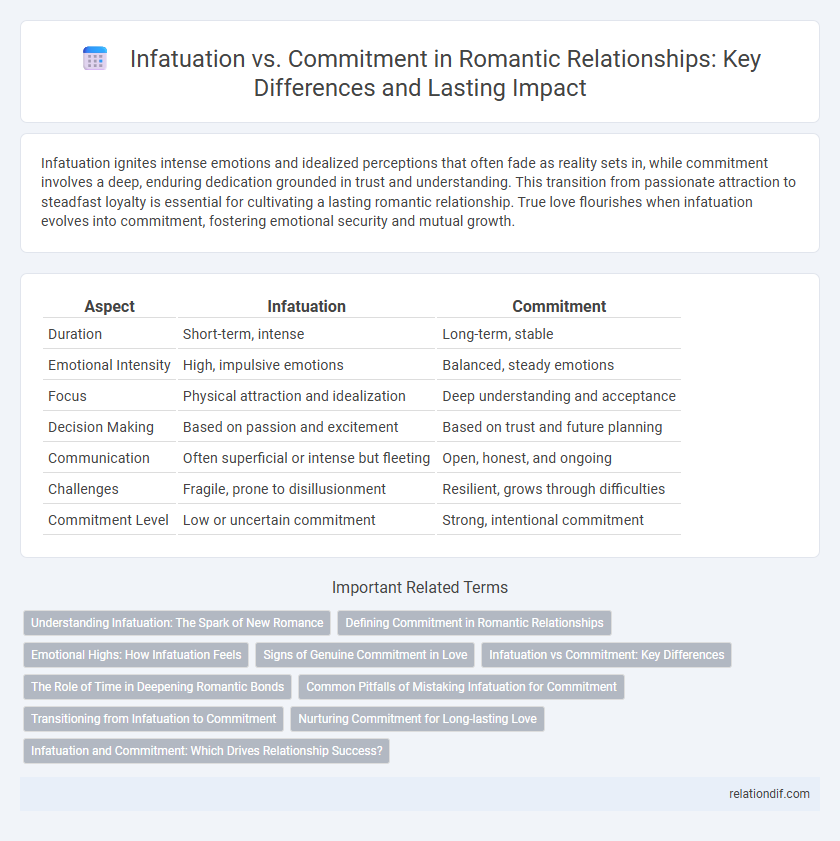Infatuation ignites intense emotions and idealized perceptions that often fade as reality sets in, while commitment involves a deep, enduring dedication grounded in trust and understanding. This transition from passionate attraction to steadfast loyalty is essential for cultivating a lasting romantic relationship. True love flourishes when infatuation evolves into commitment, fostering emotional security and mutual growth.
Table of Comparison
| Aspect | Infatuation | Commitment |
|---|---|---|
| Duration | Short-term, intense | Long-term, stable |
| Emotional Intensity | High, impulsive emotions | Balanced, steady emotions |
| Focus | Physical attraction and idealization | Deep understanding and acceptance |
| Decision Making | Based on passion and excitement | Based on trust and future planning |
| Communication | Often superficial or intense but fleeting | Open, honest, and ongoing |
| Challenges | Fragile, prone to disillusionment | Resilient, grows through difficulties |
| Commitment Level | Low or uncertain commitment | Strong, intentional commitment |
Understanding Infatuation: The Spark of New Romance
Infatuation ignites the initial spark in new romance through intense attraction and idealized perceptions of a partner, often fueled by biochemical reactions like dopamine and adrenaline release. This phase is characterized by heightened emotional arousal and obsessive thoughts, which can overshadow rational judgment and long-term compatibility assessment. Recognizing the transient nature of infatuation helps differentiate it from deeper commitment, which involves trust, mutual respect, and sustained emotional investment over time.
Defining Commitment in Romantic Relationships
Commitment in romantic relationships involves a conscious decision to maintain a long-term bond characterized by loyalty, trust, and emotional support. Unlike infatuation, which is often intense but short-lived and driven by physical attraction or idealization, commitment requires consistent effort, communication, and mutual understanding. This dedication helps build a stable foundation for enduring partnership and deeper intimacy.
Emotional Highs: How Infatuation Feels
Infatuation ignites intense emotional highs characterized by obsessive thoughts and a euphoric rush of dopamine, creating a powerful but often fleeting sense of excitement and idealization. This emotional intensity can lead to impulsive decisions driven by passion rather than reason, distinguishing infatuation from the steady emotional foundation found in long-term commitment. Understanding these emotional contrasts helps individuals navigate early romantic stages with greater awareness and clarity.
Signs of Genuine Commitment in Love
Signs of genuine commitment in love include consistent communication, reliability, and prioritizing your partner's well-being over time. True commitment manifests through shared goals, emotional support during challenges, and mutual respect that deepens trust. Unlike fleeting infatuation, committed love grows stronger with patience, honesty, and unwavering dedication.
Infatuation vs Commitment: Key Differences
Infatuation is characterized by intense, short-lived passion driven primarily by physical attraction and idealized perceptions, whereas commitment involves a long-term dedication based on trust, understanding, and emotional investment. Infatuation often leads to impulsive decisions and heightened emotional highs, while commitment fosters stability, effective communication, and shared goals. Understanding these key differences helps individuals navigate romantic relationships with clarity and intentionality.
The Role of Time in Deepening Romantic Bonds
Infatuation often ignites quickly with intense emotions and idealized perceptions, but commitment emerges through sustained effort and shared experiences over time. The role of time in deepening romantic bonds allows partners to build trust, understanding, and emotional intimacy beyond initial attraction. Psychological studies highlight that long-term relationships strengthen neural connections related to attachment and reward, reinforcing commitment beyond the fleeting nature of infatuation.
Common Pitfalls of Mistaking Infatuation for Commitment
Mistaking infatuation for commitment often leads to unrealistic expectations and emotional volatility due to the intense but short-lived nature of infatuation. This confusion can result in neglecting essential relationship foundations such as trust, communication, and long-term compatibility. Recognizing the difference helps build stable partnerships grounded in mutual understanding and genuine affection rather than fleeting passion.
Transitioning from Infatuation to Commitment
Transitioning from infatuation to commitment involves shifting focus from intense emotional highs to deeper emotional understanding and trust. This stage requires recognizing the value of long-term compatibility, communication, and shared goals beyond initial attraction. Developing commitment fosters stability and growth, transforming fleeting passion into enduring partnership.
Nurturing Commitment for Long-lasting Love
Nurturing commitment in romance requires consistent communication, emotional support, and mutual respect to build a foundation for long-lasting love. Infatuation often hinges on intense, short-term attraction, whereas commitment emphasizes growth through shared experiences and understanding over time. Couples who prioritize trust, empathy, and patience foster deeper connections that withstand challenges, leading to enduring relationships.
Infatuation and Commitment: Which Drives Relationship Success?
Infatuation ignites intense passion and excitement in the early stages of a relationship, often driven by idealized perceptions and strong emotional attraction. Commitment, by contrast, nurtures long-term relationship success through trust, mutual respect, and consistent effort to resolve conflicts and maintain emotional intimacy. Research indicates that while infatuation sparks initial connection, commitment is the key factor in sustaining healthy, enduring romantic partnerships.
Infatuation vs Commitment Infographic

 relationdif.com
relationdif.com